Want to just get started? Click here to sign up for WebiMax and start removing personal information from Google today.
We’ve all heard it said all before—once on the internet, always on the internet. But this saying doesn’t have to be true.
The internet can be a daunting place, and although information is timeless, it can also spread like wildfire. Sometimes personal information can make its way onto the web without your consent or by complete accident—and let’s be real here, there are many reasons why people want information removed from the depths of Google.
If this is the case for you, here are six steps to help you remove personal information from Google for good.
6 Steps To Remove Personal Information From Google
Removing personal information from Google won’t always involve deleting content from the pages you own. Here are six crucial steps to help you remove this information as efficiently as possible:
- Start with a quick Google search
- Delete information from pages you control
- Contact webmasters from sites you don’t control
- Contact Google
- Delete information from collection sites
- Monitor your personal information
The Easy Parts of Removing Personal Information From Google
Contrary to popular belief, removing many forms of personal information from Google is possible and easy. Whether you want to avoid identity theft, get rid of problematic blog posts, or shut down misinformation, an online reputation management company can help you do just that.
WebiMax is a leading digital marketing agency specializing in reputation management for small businesses. After a free reputation analysis, you will receive a report that lists all the negative online content about you or your company.
WebiMax gives you the option to either delete this content altogether or suppress the harmful search results instead, as Google is sensitive to certain types of content, such as anything involving the law.
Another easy part of this process is removing your own content from Google. If there is any information you’ve put on the internet yourself, it is quick and easy to remove if you still have access.
Start by removing personal information from your website’s content wherever it appears. If you have personal information in your blog posts on the website, don’t forget to edit these posts. Then move on to your posts on places like Twitter, YouTube, and Facebook and remove any personal information you now want to hide. Google’s search engine will include information from social media in some searches, so you will need to edit these posts.
It is worth mentioning here that Google is doing a better job of valuing its users’ privacy. Thanks to changes Google made to its policies in the past few years, it is now easier than ever to make a request to have personal information removed in Google. In some cases, you may not even have to show that the data you want to remove is dangerous.
As another positive step, Google recently promised to give users the ability to make the request to remove personal data through the Google app or after doing a Google search on the web. This step would make the process of requesting removal of your information easier than ever.
Online reputation management services can also take advantage of these privacy-friendly steps from Google to help you more thoroughly protect and remove your personal information from Google searches. After all, it still remains time consuming to track down your personal information on Google. You may prefer to hire the reputation company to do this for you, so you can focus on running your business.
The Difficult Parts of Removing Personal Information From Google
When it comes to removing personal information from Google, the potential difficulty depends on what kind of information you want removed and from what pages. If you want to remove content from another person’s page, getting in contact with that person can often be time-consuming, and there’s no guarantee that you will hear back from them—or that they’ll be open to removing the content if you do.
It can also be challenging to remove content for legal reasons because there are different processes and regulations you have to abide by to have content removed from Google.
Staying organized and keeping pace with all of your personal information also poses its fair share of challenges. While you might succeed in removing personal information from some sites, other sites might be publishing new information about you.
So you need to stay vigilant and know that this likely won’t be a one-and-done initiative. There’s a chance you’ll have to repeat this process in the future.
Step 1: Start With a Quick Google Search
Before attempting to remove any personal information from Google, you will need to know what’s out there first. The easiest way to do this is to start with a quick Google search of either your name or business name.
Turn On Incognito Mode
Before you begin searching, you should put your browser in incognito mode to prevent some tracking and auto-filling from your previous internet usage. Here are quick shortcuts for going incognito mode on both Mac and Windows.
- Incognito mode for Mac: Press Ctrl + Command + N
- Incognito mode for Windows, Linux, or Chrome OS: Press Ctrl + Shift + N
Alternatively, you can open Google Chrome on Mac or Windows and click the three vertical dots in the top right-hand corner of the screen and click New Incognito Window instead.
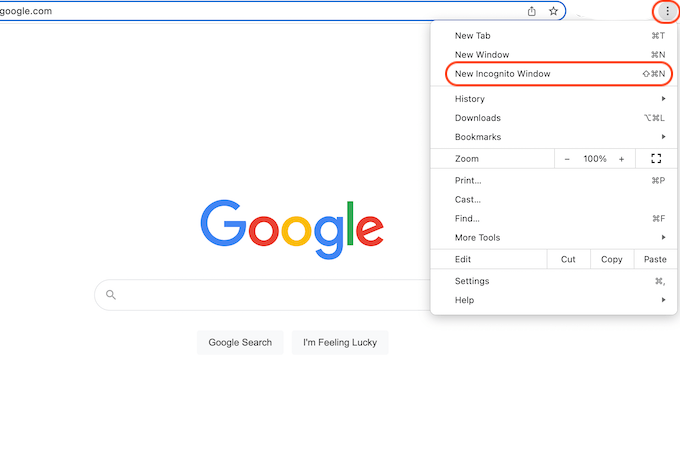
Search Google and Google Images
Once you look through Google’s search results, don’t forget to look at Google Images as well. Google Images can store different information and data and can often help you find more content you wish to remove in an easier way than looking through pages of links.
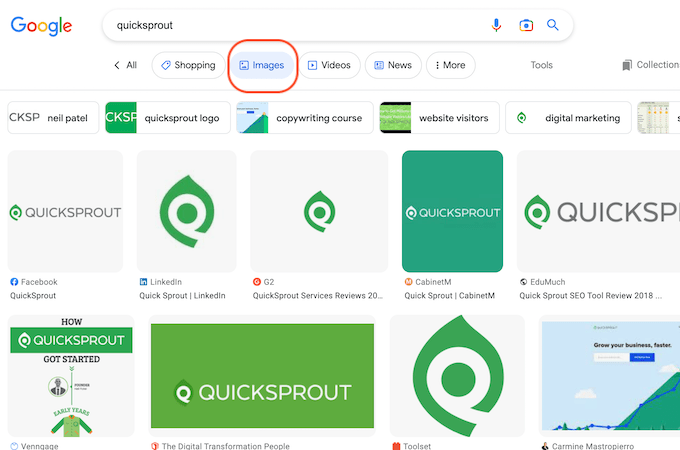
Depending on what you want to remove, it’s best to look through at least the first three pages of Google search results and images to understand how much content there is.
Scan through the Video and News results too. These can often yield different results than the standard Google search.
People are mentioned by name with other personal identifiers in news stories all the time. It’s less likely that your personal information will appear in a video, but it’s definitely possible.
Either way, it’s worth the extra few minutes now to see everything that’s out there about you.
Step 2: Delete Information From Web Pages You Control
Firstly, you can remove personal information from Google by removing it from all the web pages you have control over. Here are three of the most common web page categories and how to go about removing information from these pages:
Social Media
Social media accounts are one of the easiest ways for information to spread online, making it difficult to remove every little aspect of data—especially if the information you want to remove has gone viral.
If you are active on platforms like Facebook, Instagram, Twitter, Pinterest, or Snapchat, it’s better to deactivate these accounts entirely, depending on how much you want to remove. It can be time-consuming to remove every Facebook status or picture on your Instagram feed, although it is doable.
On the other hand, if deactivation isn’t on the table for you, you can always make your social media accounts private and remove any sensitive information instead. For example, on Facebook, you can adjust your privacy settings to prevent Google from linking to your profile, here’s how:
- Click the down-facing arrow in the top right of Facebook
- Select Settings & Privacy, then click Settings
- In the left column, click Privacy
- Click Edit next to Do you want search engines outside of Facebook to link to your profile?
- Review your current settings and decide on the settings you want.
Website Domains
If you own a professional website, this counts as a website domain and is a separate entity with its own data and information. If you operate a website, the easiest way to remove any personal information is to log in and delete the content you want to.
If you don’t have access to the backend of your website anymore, you can contact your domain admin for access. If you ask an admin to grant you access, you may need to provide personal information to prove your identity.
Blogs
Whether you operate a blog on WordPress, HubSpot, Blogger, Weebly, Wix, or another blog site—you will be able to log in and remove any information you own. Again, if you don’t have access to these, you can always contact admin support for help.
If you operate a blog with more than one person, it’s imperative to let all parties know what information you will be removing. Getting consent from all parties to remove content ensures that no one will reupload this content again.
Professional Profiles
Professional networking websites like LinkedIn contain lots of personal information about yourself, including your location, job history, education, and more. So when someone searches for your name on Google, this type of personal info might be one of the first hits.
Even your LinkedIn profile picture can appear in the search results.
If you don’t want this information to be made publicly available on Google, you need to delete it from LinkedIn or delete your profile altogether. This holds true for other sites containing your digital resume, like Monster or Indeed.
Step 3: Contact Webmasters From Sites You Don’t Control
Because Google gathers information, content, and data from across the internet, there will be times when the information you wish to remove will be behind a web page you don’t own. In these situations, contact the webmaster and ask them to remove the information.
Contacting the site owner is the only viable way to remove this content. Even if Google deletes the site or image from its search results, it’s still visible through a URL, social media sharing, or other search engines like Bing or Yahoo.
There are four ways to contact the webmaster to remove content:
Find Contact Information on a Website
Most websites will have a “Contact Us” link somewhere on the homepage. Alternatively, there will be an email address you can contact.
Generally speaking, it’s better to send any requests to a specific person rather than a general contact inbox. Some of those contact forms are designed for leads or support, and other types of communication get ignored.
Emailing an editor, writer, or publisher directly also helps humanize the request. You’re speaking directly to a person instead of a nameless and faceless company. The fact that you’ve reached out to them directly could also be favorable for your case since many professionals don’t want to have any problems or friction associated with their names.
For example, let’s say you’re trying to get a news article removed from the web. If the publisher didn’t have permission to use your name in an interview, then you can contact them directly with your complaint. Their reputation might be on the line if they don’t comply.
At the end of the day, some form of contact is better than nothing. So you can always use the “Contact Us” route as a last resort if you can’t find someone’s direct email address.
Find Contact Information Using Whois
If the webmaster you are trying to get in contact with doesn’t have any contact information on their website, you can opt to search within the Whois database. Every domain name has a Whois listing, and without domain privacy or Whois privacy protection, this listing information is available to the public and includes the owner’s name, email address, and phone number.
Here’s how to find contact information using Whois and Google search:
- Go to Google.com
- Search Whois and the website domain name
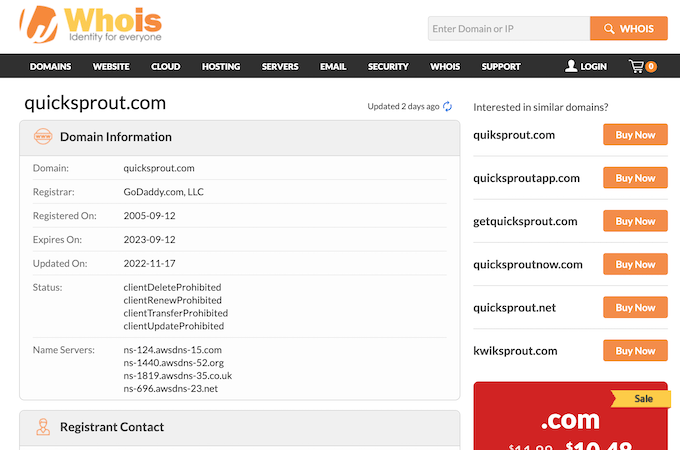
Alternatively, you can search for the domain name on the Whois website via its Domain Lookup feature.
Contact the Site’s Hosting Company
If all else fails and you can’t retrieve the contact information from either Whois or the owner’s homepage, you can always attempt to contact the site hosting company.
Whois also provides the hosting information, but contacting them should be a last resort. Contacting the site hosting company may be time-consuming and involve additional information.
Hire a Reputation Management Company
Rather than manually locating all personal information about yourself on the web and contacting each publisher, you can always hire someone to do it for you.
This is often the easiest way to delete information that’s out of your control.
There are certain ways to de-index pages that contain your personal information. So while that information will technically still be on the web, the information won’t be indexed in Google—which effectively eliminates all unwanted search results.
If you need help with removing personal information from Google, here are the best online reputation management companies to help you do this effectively and on a friendly budget.
Step 4: Contact Google
The good news is that if you still can’t get in contact with the webmaster or are locked out of your website, you can contact Google, and it will remove personal information for you. However, there are specific types of content that Google will remove, and you will have to prove that the information creates a significant risk for identity theft, financial fraud, or other harm.
Here is what to expect when contacting Google for content removal:
Types of Removals Available
First, you will need to know the types of removals that are available. Here is a list of the current types of content that Google will remove from its search results:
- Non-consensual or explicit images
- Involuntary fake explicit content
- Content about you on sites with exploitative removal practices
- Personally identifiable information (PII) or doxxing content
- Images of minors
- Irrelevant explicit content from Google search results with your name
Each category requires slightly different information for you to submit a removal request. However, the most common requirements you will need are your name, the URLs, websites, or imagery associated with the content. Aura has a good list of additional tips on different types of removable personal information.
Outdated Content
On the other hand, you can also request that Google remove outdated content that was shared or published on other websites you don’t have access to. You can do so by using its free Outdated Content Tool.
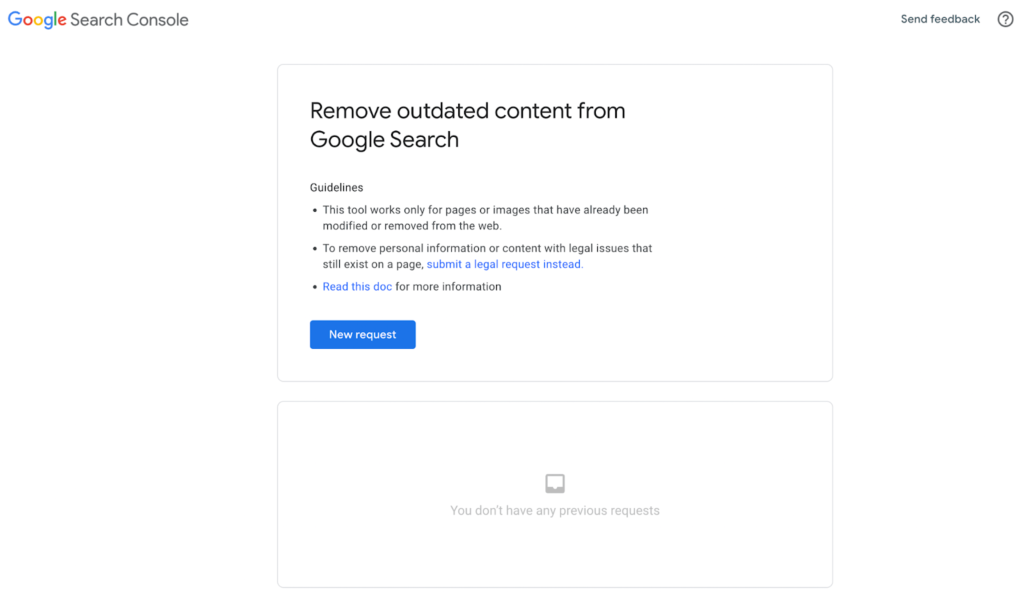
However, this is strictly for outdated info. You shouldn’t use this tool if:
- You think the information on the page or image is wrong, bad, or illegal
- You are a verified owner of the page
- You want to permanently remove a search result for a URL that is publicly accessible
- You want Google to recrawl a page
- The information is still on the live page
Removing Content For Legal Reasons
Legal disputes happen, and if you wish to remove information for legal purposes, you can also do this by requesting a removal through Google. Legal requests are more sensitive than other requests, so it’s crucial that you make sure you have the right information.
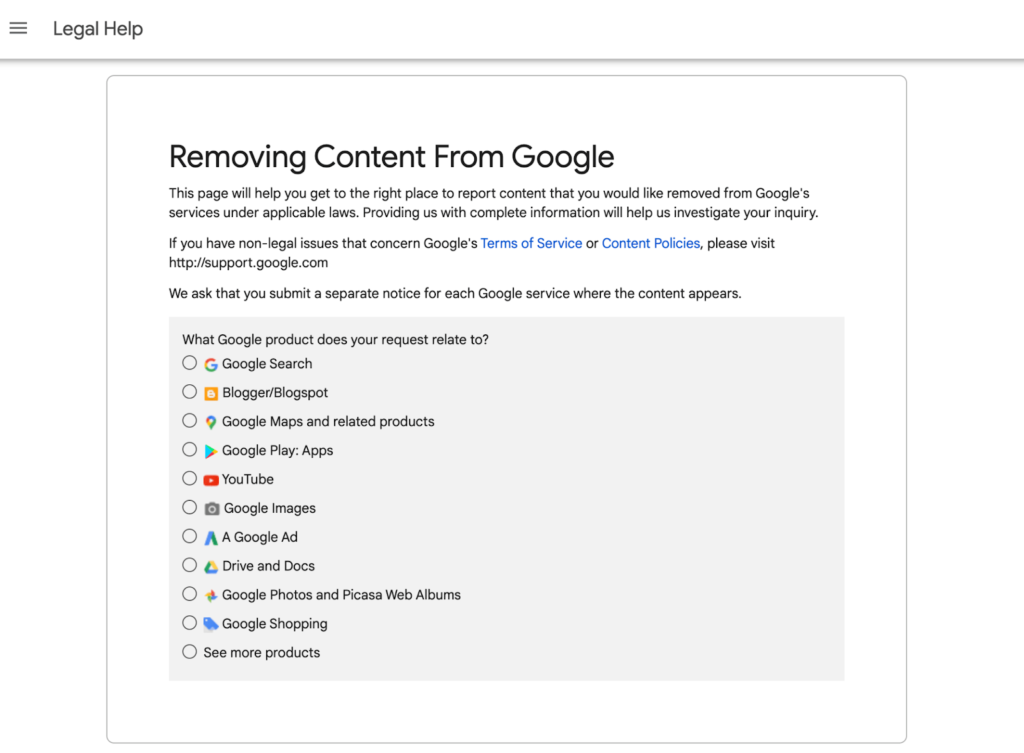
You can request the removal of content that includes malware, phishing, intellectual property use, defamation, court order, or abusive/explicit material.
Step 5: Delete Information From Collection Sites
The final step is a bit tedious. We should also warn you that it’s impossible to remove every piece of your data floating around on the web. With some work, however, you can get pretty far.
To get started, seek out various websites that collect data and request that they remove your information.
Find Data Collection Websites on Google
Google will be a helpful resource as you go through this process. Simply search for data collection companies on Google, and create a list of sites that collect your data for different purposes.
There are many data collection services, so you’re going to have your work cut out for you. But there are some heavy hitters out there you can start with. These include familiar names like Spokeo, Radaris, Whitepages, Intelius, MyLife, and BeenVerified.
To be sure, there are a lot more than these, and you may not find them all. Going through each one you do find will also be a lot of work. Possibly more than you want to do yourself. This is where using an online reputation monitoring tool can be worth the expense.
Opt-Out
If you choose to tackle this task on your own, be confident it can definitely be done. Here’s how.
Take the list you curated from Google and use it to visit each data collection service to opt out manually. Once you land on a site, you should be able to find an opt-out form at the bottom of the page in the footer section.
Let’s walk through the process on the well-known data collection site Spokeo.
- Search for your profile on Spokeo.com.
- Once you find it in the search result listings, go to your profile and copy the URL (you won’t need to register or pay for anything to look at your high-level profile).
- Navigate to the opt out page for Spokeo.
- Paste your URL, add your email address, complete the CAPTCHA and click Remove This Listing.
You’ll receive a confirmation email that contains a verification link. Follow the link and complete a final confirmation step to complete your removal request.
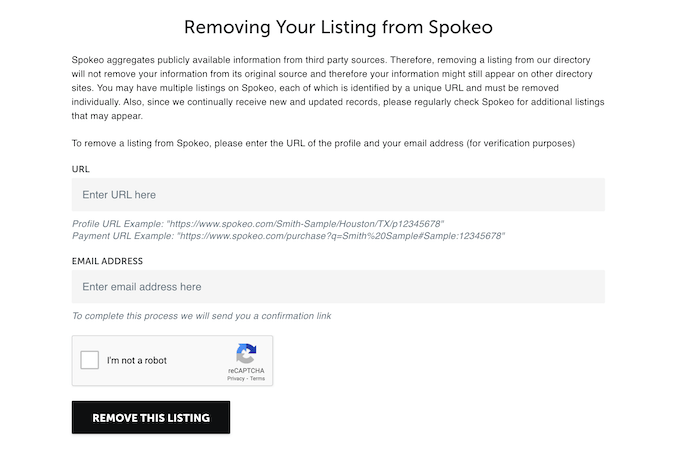
The process will vary slightly for each data collection service. If you have trouble finding the opt out page for a service, you can always do a Google search of “[service name] + opt out” to expedite things.
Keep in mind that the opt-out process won’t be instant. It’ll likely take one to two weeks for the site to remove your data after it receives your request. Be sure to check after two weeks to see if the site still has your data so that you can reach out to the company if necessary.
Step 6: Monitor Your Personal Information
Removing your personal information from Google doesn’t prevent it from getting re-published elsewhere. It could even appear again on some of the same websites and platforms you’ve previously removed it from.
So you’ll need to monitor your personal information on an ongoing basis so you can quickly delete it if it shows up on Google.
Set Up Alerts
The easiest way to see if your personal information is back on Google is by setting up Google Alerts. This a free tool that notifies you whenever your name, business name, or certain keyword gets published online.
These alerts can be sent to you in real time via email. Alternatively, you can set them up for daily or weekly searches.
The cool part about Google Alerts is that you can even control which sources the alerts come from. For example, you can set up alerts for your name on news sites and discussion forums. But you may choose to eliminate blogs since you might get unnecessary notifications every time you publish a new blog post on your website.
If you’re working with an online reputation management company, they can likely set up brand alerts on your behalf. Lots of these services provide ongoing monitoring, and they’ll automatically take steps toward removal for each new instance of your personal information getting published on Google.
Consider Legal Action
If you continue to see your personal information appear on the same sites where you’ve removed them or if your removal requests are being ignored, you could potentially take legal action against the website.
But you should tread very cautiously here. This could end up being an expensive approach that ends with your personal information remaining online.
You could sue a website for publishing your personal information if it’s false, and you can prove damages or imminent injury. However, just because you can sue them, it doesn’t mean you should.
Lawsuits can take a while to move through the court systems, and it just further delays the results you’re looking for.
Alternatively, you could have an attorney draft a strongly-worded letter that hints at a lawsuit. This might be enough for a webmaster to ultimately remove your information.
Make sure you consult with a lawyer before you go this route.
